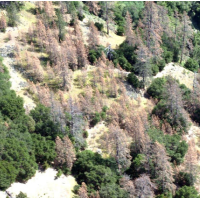Drought Killed More Than 12 Million Forest Trees Last Year; Lawns Are Next
 Pine trees in Los Padres National Forest (photo: U.S. Forest Service)
Pine trees in Los Padres National Forest (photo: U.S. Forest Service)
The drought killed more than 12 million forest trees in California last year, and now the state has officially authorized that lawns are next.
The State Water Resources Control Board adopted sweeping water restrictions Tuesday that will strongly encourage homeowners to crisp their lawns and urbanites to cut their water use 25%, on average, as per Governor Jerry Brown’s executive order on April 1. Mandatory water cuts will range between 8% and 36%, depending on location.
For those optimists hoping that their own voluntary response to the governor’s plea for conservation a year ago might portend the saving of their lawns, the board’s revelation that Californians’ cut back a meager 3.6% in March compared to the year before is not encouraging.
The regulations will take effect in the summer, when outdoor sprinkling usually accounts for 50% to 80% of residential water use. As the water board knows, the biggest impact comes from targeting the largest percentage of use and tailoring a solution for slashing it.
But it didn’t put that knowledge to use by targeting farmers, who use 80% of California’s water. When Governor Brown announced the 25% cut, he said agriculture had borne the brunt of the drought to date and they would only “be required to report more water use information to state regulators.”
As for the other 20% of us, he promised “real reductions in a number of areas, that include golf courses, people’s lawns, universities’ campuses, all sorts of institutions, the medians with vegetation on our roads and highways.” It remains to be seen how the regulations will be enforced but the board said it still expected to see major gains beginning in June.
There has been pushback of late by agricultural interests and conservatives to reframe the discussion over conservation by inserting one more element into the equation that assigns 80% of water use to agriculture and the rest to industrial, commercial and residential use. They would like the environment to be blamed for sucking up 40% to 50% of the state’s water.
Those environmental uses can be divided into four categories, according to the Public Policy Institute of California (PPIC): “water in rivers protected as ‘wild and scenic’ under federal and state laws, water required for maintaining habitat within streams, water that supports wetlands within wildlife preserves, and water needed to maintain water quality for agricultural and urban use.”
But an argument could be made along the lines of Governor Brown’s reprieve for agricultural interests, that the environment has already suffered enough.
Amid daily notices of stressed out ecosystems and threatened species, a U.S. Forest Service aerial survey of 4.2 million acres conducted last month found 12 million trees died last year in Southern California and the southern Sierra Nevada mountains because of drought. Lack of water fosters pest infestations that exacerbate an already critical situation.
“It is almost certain that millions more trees will die over the course of the upcoming summer as the drought situation continues and becomes ever more long term,” Jeffrey Moore, acting Forest Service regional aerial survey program manager, told the Los Angeles Times.
–Ken Broder
To Learn More:
California Regulators Approve Unprecedented Water Cutbacks (by Fenit Nirappil., Associated Press)
Emergency 25% Cut In California Cities' Water Use Approved (by Matt Stevens, Chris Megerian and Monte Morin, Los Angeles Times)
California Drought Killed 12 Million Forest Trees Since Last Year (by Susan Murphy, KPBS)
California's Drought Has Killed over 12 Million Trees in the Last Year (by Mollie Reilly, Huffington Post)
Millions of Trees Are Dying Due to California Drought (by Veronica Rocha, Los Angeles Times)
Brown Announces Mandatory Water Cuts for Urban Users; Mentions Farmers in Passing (by Ken Broder, AllGov California)
- Top Stories
- Controversies
- Where is the Money Going?
- California and the Nation
- Appointments and Resignations
- Unusual News
- Latest News
- California Forbids U.S. Immigration Agents from Pretending to be Police
- California Lawmakers Urged to Strip “Self-Dealing” Tax Board of Its Duties
- Big Oil’s Grip on California
- Santa Cruz Police See Homeland Security Betrayal in Use of Gang Roundup as Cover for Immigration Raid
- Oil Companies Face Deadline to Stop Polluting California Groundwater





